The Old White, Greenbrier Resort
White Sulphur Springs, West Virginia, United States of America

One of the earliest Redans built in the United States is found at the Greenbrier courtesy of the father of golf course architecture, Charles Blair Macdonald.
Built in 1913, The Old White was an early design pillar in American golf. As frames of reference, historic Shinnecock Hills, Merion, Oakmont, and Charles Blair Macdonald’s own Chicago Golf Club were but design shells of what they would become. Construction of Pine Valley was just underway in April of that year and the Cascades Course across the Virginia line at the Homestead Resort was a decade away.
More than any individual, C.B. Macdonald enhanced the American golf landscape during the teens of the twentieth century. Opened in 1910, his National Golf Links of America (NGLA) joined Herbert Leeds’s Myopia Hunt as one of the few American courses that stood comparison with the best in the United Kingdom. Other major works by Macdonald appeared shortly thereafter including Piping Rock in Locust Valley on Long Island and Sleepy Hollow in the not yet golf rich Westchester County of 1914.
In 1913, Macdonald and his construction supervisor Seth Raynor were also preparing to add golf to the polo on offer at Saint Louis Country Club in the Midwest. Nonetheless, the most important designs occurred at private clubs predominantly in the northeast. The Pinehurst Resort in North Carolina represented a rare exception in offering first class venues to vacationing golfers (Side Note: No. 2 wasn’t nearly the course we so admire today and in fact, it wasn’t even the best course at the resort).

The Old White Hotel, for which the course is named, stood from 1858 to 1922 before being replaced with this iconic structure.
When the original owners of the Greenbrier (the Chesapeake and Ohio Railroad) sought business from the north to supplement their base of southern tourists, they realized that the existing nine hole course was insufficient. Based on the acclaim heaped upon Macdonald for his success at NGLA, the railroad retained him to build a world-class eighteen hole links.
As was his custom, Macdonald (who was already 57 years old at the time) had Raynor perform the lion’s share of both the initial work and the subsequent refinements. Macdonald surely was pleased by the prospect of building a resort course that would attract decision makers from afar (President Woodrow Wilson was among the first to play here!) and for the opportunity to expose a wide range of people to the great sport of golf.
Along with the Mid Ocean Club in Bermuda, this creation was the only other true outpost course that Macdonald designed. To its detriment, it was built on the rockiest site with which he ever worked. To its benefit, the low humidity and comfortable summer temperatures made it ideal for both growing grass and playing golf through the summer months. In particular, plantation owners from Charleston, South Carolina regularly escaped the sweltering heat by summering at the Greenbrier.
Ace player H.J. Whigham summarized the appeal of the Old White in the following Town and Country magazine article published after the course opened in 1914:
The New Golf Links at White Sulphur Springs are beyond a doubt one of the finest courses in the country. The situation, in a narrow valley flanked by wooded mountains, is one of great natural beauty, reminding the traveler of the golf links at Pau in France which has long been celebrated as one of the most beautiful in Europe. And, next to the character of the soil, scenery is the most important asset that a golf links can possess. In this case the two main prerequisites are combined; for the alluvial deposit of the valley provides all that is desirable in the way of soil. Added to these natural advantages is the factor of golf architecture which has come to be recognized as the newest feature of American golf. The most modern ideas have been applied to the laying out of the new course.
The distance for the eighteen holes is 6,250 yards, an ideal length for a first-class course. And the holes embrace many of the features which are associated with the National Golf Links at Southampton, L.I. Mr. C.B. Macdonald, the founder of the National, who is recognized as the greatest authority on golf architecture in the country, has kindly lent his assistance, and his advice has been carried out by Mr. Seth Rayner (sic). As might be expected, many of the holes are reminiscent of the National and Piping Rock. The short holes, by which a golf course generally stands or falls, are all first class. They include a “Redan” and an “Eden” hole, and a full drive hole taken from Biarritz in France which has also been used at Piping Rock.
The longer holes are well conceived, and they include two or three holes of the “dog’s hind leg” variety without which no modern course is complete. The ground is naturally undulating, presenting many natural features which give individuality to the course, while the river makes a splendid water hazard in four holes. It would be difficult to imagine a more fortunate combination of circumstances. The soil is a light loam, excellent for growing the finer grasses, but not to heavy for play in wet weather. The contours lend themselves to the making of good holes, and the river is the best kind of water hazard.
It is impossible to make first class golf courses in these days without spending money. It is calculated that the work of laying out the new course has cost at least sixty thousand dollars, irrespective of the money spent in moving some buildings which interfered with the first tee and last hole. But is money well spent, since the climate of White Sulphur Springs is such that it can be made a golfing center all the year round. And it is one of the few places in the Southern States where the turf is like the turf of Long Island or the Vermont Hills, and where the putting greens are of real grass. Indeed, the putting greens are one of the fine features of the new links.
In addition to the new course the old nine holes are open to play, as they will always be needed as a subsidiary course for beginners or for less ambitious golfers. The architects of the course have not forgotten that White Sulphur Springs is a pleasure resort, and while they have got as far away as possible from the regular type of hotel course, they have not made the task too severe for those who regard golf as a holiday pastime.
The Old White’s creation was an important transition for both golf course architecture and the concept of resort golf. Many influential people vacationed at the Greenbrier and the Old White helped shape opinions as to what quality inland golf could be in the United States. Alas, though important from an historical perspective, the course was not always treated with reverence and care that it deserved. Every passing decade after World War II saw Macdonald and Raynor’s features slowly disappear. By the start of the new century, the course had devolved into a bland straightforward affair, albeit in a pretty setting.
According to Richmond, Virginia based golf course architect Lester George, ‘The Old White was very pedestrian by the year 2000. Round bunkers, round greens, splotchy tees and meaningless mowing patterns had rendered it unrecognizable as a Macdonald/Raynor course. The only thing remotely resembling the original course was the routing and even that had to be reinstated in fourteen places.’ CSX Corporation owned the Greenbrier at the time and realized that something needed to be done. The question was what? Continue along the lines of modernization? Six architects were consulted, including George. The management team at the Greenbrier, led by the then Director of Golf Robert Harris, eventually selected George to restore The Old White to its 1922 configuration after Raynor’s final visit. According to George,
‘Being a fan of Macdonald, Raynor and Banks (I was working on Banks’ Cavalier Golf and Yacht at the time) I implored the Board to let me conduct a sympathetic restoration. Robert Harris, the Director of Golf at the Greenbrier at the time, supported the idea and we went to work on plans almost immediately in the fall. Both Robert and Bob Conte (Greenbrier Historian) were very helpful in gathering up many old photographs and maps of the property. In particular, a late 1920s aerial photograph that was part of a brochure ended up being the most valuable piece. We blew that brochure photograph up to a four foot by eight foot image and worked very hard at adjusting the resolution until we unlocked the secrets of the original course. We found by studying shadows on the plan and measuring the shadows of landforms and building that still existed, we could determine the shape, size and depth of bunkers creeks and hillocks. We could also see clearly all the bunkers that had been abandoned and filled in over the years and we could tell the shape and sizes of the greens. This photo became our archeological map. All design decisions were desk checked against this photo.

This aerial proved invaluable to Lester George in restoring The Old White to its former glory.
The transformation that occurred in a scant three years was nothing less than astonishing. Trees were felled, width was restored, Macdonald’s bunkering schemes were recaptured, and the greens were expanded out to the fill pad edges. The end result is that the golfer is once again confronted with many of Macdonald’s favorite template holes that offer appealing options and playing strategies, as we see below.
Holes to Note
First hole, 450 yards, First; Robert Trent Jones once included this hole in his dream eighteen for Town and Country Magazine. Tom Watson called the tee shot ‘the greatest opening tee shot in golf.’ For the past fifty years, it was the standout hole on The Old White. As testament to the success of the restoration, such is no longer the case as a plethora of other holes offer a comparable amount of excitement and fun.

The famed first hole with its picturesque tee high above Howard’s Creek gets the round off to a rousing start.
Second hole, 415 yards, Hog’s Back; Be it a three foot deep swale through the middle of a green or fifty yard long bunkers that slashed diagonally across the fairway, Macdonald placed features where they mattered the most: Directly in the line of play, forcing the golfer to think about what he hoped to accomplish next. Unfortunately, the more pronounced centerline features were eliminated over time ostensibly and ill advisedly to make a round more pleasurable. One of the few features that remained untouched was a two foot spine down the middle of the second fairway. As it was subtle, it escaped alteration and was left untouched. The golfer who plays a cut off the tee into the right center of the fairway is rewarded with a kick forward and the ideal angle into the green. The golfer who steers away from Howard’s Creek on the right will likely see his tee ball kicked farther left off the hog’s back, leaving him an awkward approach angle.

Tee balls that finish to the right of the subtle spine down the middle of the fairway afford the best angle into the green.
Third hole, 205 yards, Biarritz; One sure way to bring a smile to a Macdonald fan’s face is the sight of a full length Biarrtitz green. Even Macdonald’s masterpiece at National Golf Links of America doesn’t have one and some that do have the swale before the green maintained as fairway as at Piping Rock. This 63 yard deep green with its massive 15,286 square foot (!) putting surface is the “full monty” and it is hard to imagine a more interesting hole over flat land. Before the restoration, the third featured an oval green one third the size and none of the character.

Biarritiz greens are supreme in the flexibility that they afford as witnessed by comparing these two hole locations. The beast of all beast ones is far back left beyond the swale as seen above late one afternoon.

The very next morning, the hole is down in the swale which is as fun as fun can be.
Fifth hole, 345 yards, Mounds; Referred to locally as Dragon Teeth, several holes at The Old White possess sharp conical mounds, which are unique as Macdonald never employed them elsewhere. The reason? As Raynor was building the course, he needed a place to pile rock as they weren’t going to cart it very far. At several places, they piled the rubble together and then grassed it over. No where do the mounds come more into play here.

The five mounds to the left of the fifth green are unique within Macdonald’s body of work.

As seen from behind, no joy is gained from becoming ensnarled in them.
Sixth hole, 470 yards, Lookout; The template holes of Macdonald and Raynor delight architecture buffs but so too do original holes well suited to the site. The fifth and sixth are such one-of-a-kind holes. A side hill presents a real design challenge and holes with this feature rarely rank among a course’s best but here is an exception. As such, it offers a real window into Macdonald and Raynor’s talent as architects in both routing and designing holes. Can the golfer place his tee ball near the forty-five yard long bunker that cuts into the fairway from the high right side? If so, he has a fine view to a green open from the right. As the natural grade of the ground shoves his tee ball left, his angle into the hole progressively worsens. This type hole whereby one shape shot is required off the tee and another into the green (e.g. a fade off the tee to hold the tee ball up against the slope and a draw to bound onto the green) is referred to as a switch back hole. While the term didn’t exist in Macdonald’s day, it is no surprise to see him at the forefront of another timeless design principle. Among modern architects, Pete Dye is the king of building such holes and he was heavily influenced by Raynor’s work at Camargo Country Club outside of Cincinnati, Ohio.

Views such as this one from the sixth tee make the golfer glad that he made the journey.

A tee ball that finishes near this long cross bunker affords the perfect angle into the green.
Seventh hole, 405 yards, Plateau; As described in Whigham’s quote on the merits of the site, the alluvial deposits in the valley provided soil satisfactory for growing grasses good for golf. It also left some fine natural one to four foot swales randomly running through the property, some of the best of which Macdonald captured within this fairway. Nonetheless, the seventh is made by its 45 yard long green. Perhaps the greatest accomplishment of the work carried out over the past few years is how markedly different many of the holes play based on the day’s hole location. Some greens such as this one require as much as a four-club difference between a forward and back hole location. A resort guest stays endlessly engaged in figuring out the best play for that day’s wind and hole location.
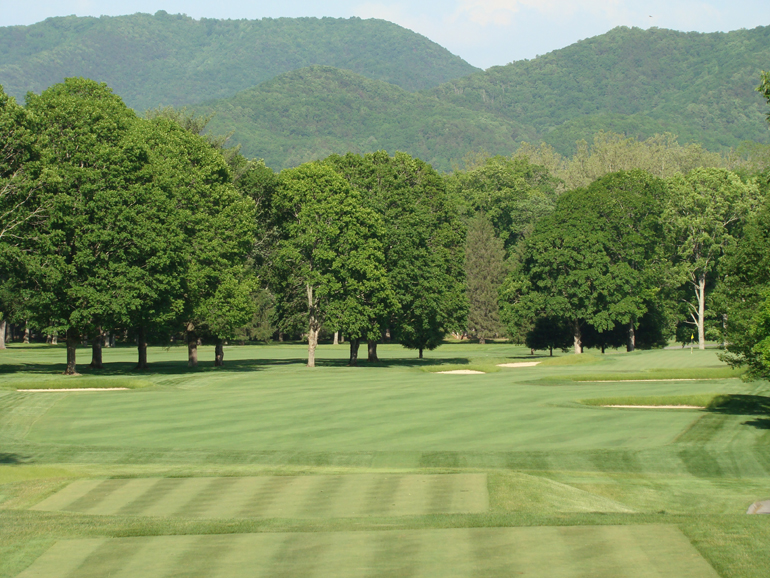
Unusual for a mountain course, the seventh fairway features nice rumples.

Front hole locations offer distinctly different challenges compared to ….
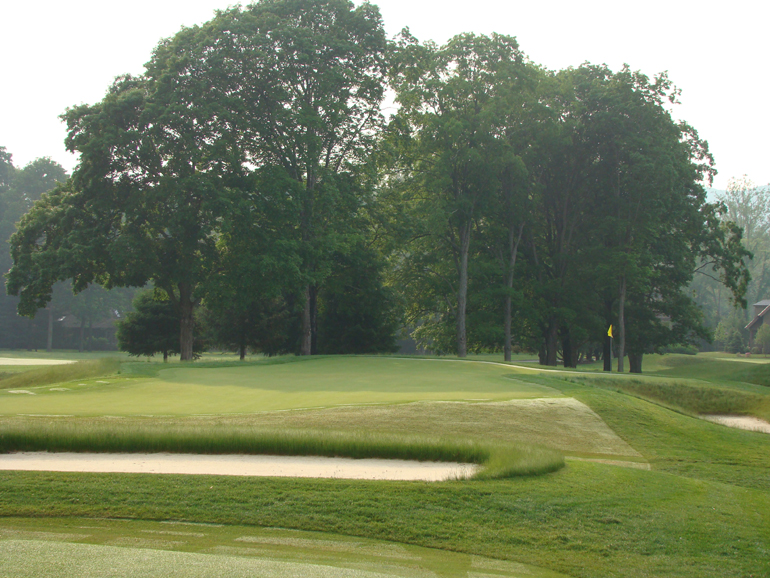
… to those back right on the lower plateau. George fully restored the imaginative contours to this deep green.
Eighth hole, 215 yards, Redan; It is hard to imagine the course withouts its current set of greens as they embody the prototypical Macdonald design elements, one of which is the ability to hit to spot X to end at spot Y. No where is that more pronounced than at the Redan where the properly shaped right to left shot can be played to avoid the course’s deepest greenside bunker. Properly shaped right to left shots that hit on the front third of the green release down the fall line of the green’s right to left cant and end up by the back hole locations. At some point, scale is required for such fun – and thrilling – shots to unfold. In 2002, Old White’s greens averaged 5,057 square feet while they now they average a robust 6,789 square feet (i.e. an average increase in putting surface of over 34%) . At 8,364 square feet, the eighth green has nearly doubled in size and once again, there is room for the Redan to play like, well, a Redan! NGLA’s Redan is famous in part because its distant backdrop makes it difficult to gauge depth perception from the tee. In contrast, the handsome backdrop of the Greenbrier Mountain highlights one of the appeals of mountain golf. Probably the most famous hole at the Greenbrier, the back tee helps it play the proper Redan length in the thin mountain air.

All the key ingredients are present for a classic Redan: A fiercesome nine foot deep front bunker, the high kick mound on the right, and a large 8,000 square foot green that slopes from front right to back left. One unique aspect to this version is the three Dragon’s Teeth prior to the bunker.
Ninth hole, 405 yards, Punchbowl; There can be no true Punchbowl green in the mountains as there exists no landforms suitable for adequate drainage. Nonetheless, this green complex admirably creates the sensation of one thanks to the high back wall of two of the deepest greenside bunkers on the course and how the putting surface is bowled out from its surrounds.
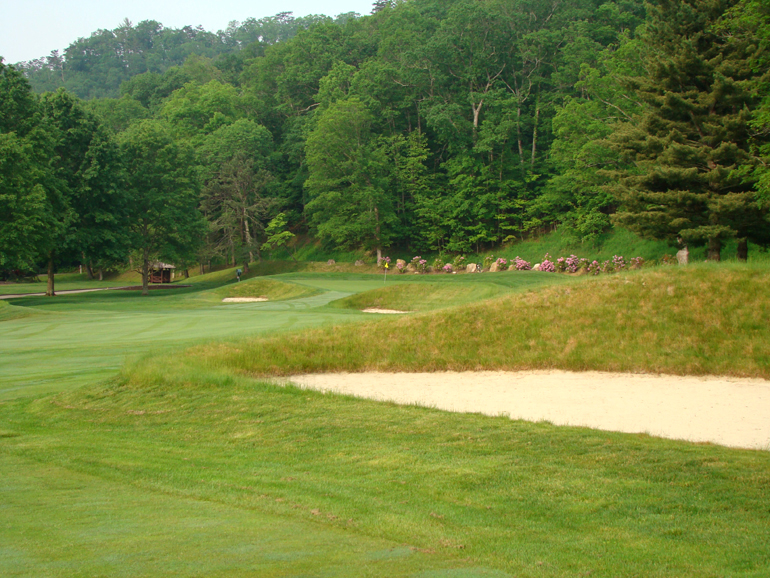
Not one of the longest two shotters on the course, the ninth still calls for a well struck approach.

Pressed up against the base of Greenbrier Mountain, the ninth green complex is one of the most well defended on the course.
Twelfth hole, 570 yards, Long; Despite being over 2,000 feet above sea level in the mountainous state of West Virginia, The Old White is by no means hilly. Indeed, half the holes feature elevation changes of less than ten feet, which helps explain why The Old White is such a pleasant walk. The twelfth and thirteenth play along the side of a hill and Macdonald seized upon the opportunity to bench two fine green sites.
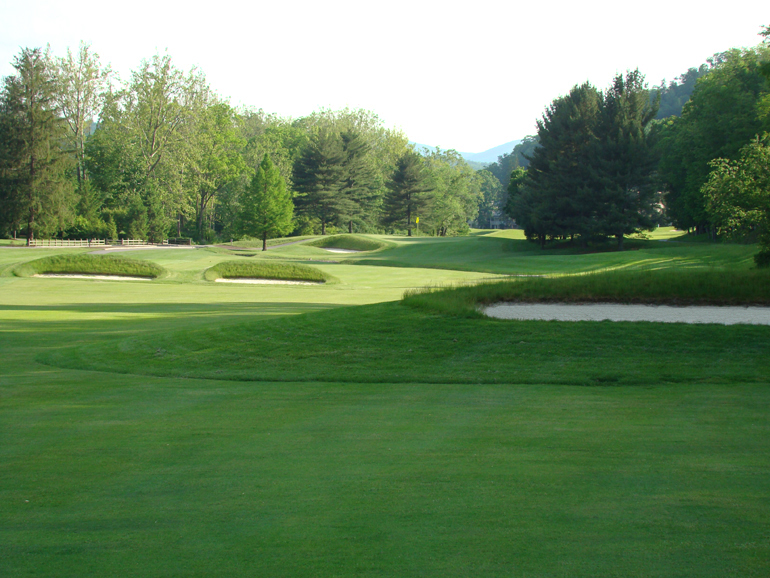
Ahead on the left, Harris and George’s well placed interpretation of Hell Bunker lends the twelfth great character. Elect to carry it and the golfer has a much shorter shot into the well situated green high on a bank above a stream.
Thirteenth hole, 450 yards, Alps; Golf at this time was a fledging sport in the United States but fortunately, Macdonald did not need to dumb down his strategic design as his golf holes typically featured width and alternative routes to accommodate the less skilled player. At the thirteenth, an uphill approach is none too demanding when hole locations are left. Tuck the hole right behind the large built up mound and scoring quickly escalates. No worries though as all range of players have a way to negotiate the hole in a manner commensurate with their playing abilities.

What’s not to like? The hole location seems imminently approachable.

Hold on! The proceedings just got more difficult. Unusual for an Alps hole, the large mound doesn’t front the entire green. A highly desirable consequence is the range in difficulty with right hole locations making it one of the course’s hardest pars.
Fourteenth hole, 400 yards, Narrows; In The Evangelist of Golf, the preeminent Macdonald historian George Bahto states that ‘arguably the most artistic arrangement of bunkering’ at NGLA occurs at the Narrows. The same applies at this namesake where the course’s longest/largest bunker at 100 yards in length is perfectly offset by a perpendicular bunker that protrudes in from the right. If the golfer carries this cross bunker, he is richly rewarded with a view down the length of the green. Conversely, as the golfer steers safely to the left off the tee, his angle of approach becomes less advantageous.

A gorgegous hole, note the oblique angle that the green is set on for approach shots from the left.
Fifteenth hole, 195 yards, Eden; Macdonald adored the Eden at St. Andrews but hated how a man could use a putter to play the hole from tee to green. Hence at both NGLA and here, the golfer shouldn’t be surprised to find water between the tee and green.

Howard’s Creek makes sure the Eden plays as Macdonald intended. Located just past the deep Strath bunker, the day’s hole location is particularly tough. Hill bunker is on the left.
Sixteenth hole, 400 yards, Cape; While not a true Cape in the context that the green doesn’t extend into the same hazard that challenges from tee, this hole nonetheless features the quintessential Cape tee shot. Courtesy of work done over the 2010 winter, the lake bites into the fairway and even the longest hitters on the PGA Tour must think about their relative target line. Apart from the obvious hazard of the water, one nice defense of the hole is its flat fairway. From the tee, not much of the fairway is visible, making it hard for any player to get completely comfortable over the tee ball. An uncertain golfer is a worried golfer with doubt and confusion rarely leading to the day’s best swing. The Golden Age architects utilized design ploys that unsettle the golfer as opposed to many modern architects who elect to mollycoddle the player with perfectly framed visuals.
Seventeenth hole, 555 yards, Oaks; A stream/creek makes for a wonderful hazard and is found with much greater frequency in the mountains than on any other golf setting. Hug Howard’s Creek by driving down the the right of the fairway and the green can be reached in two. Up ahead, eight of Old White’s seventy bunkers endow golf qualities to the rest of the flat hole. A series of the distinctive Dragon Teeth dot the right of the fairway to capture any blocked or pushed approach.

Howard’s Creek threatens the tee ball along the right of the seventeenth fairway.
Eighteenth hole, 160 yards, Home; This Short completes the classic collection of one shot holes defined by Macdonald and Raynor. The gamut of shotmaking demanded by this quartet is timeless. The long Biarritz perfectly offsets this Short and the Redan with its right to left requirements is well balanced with the Eden’s left to right bias. The most common misconception about the Short is that its challenge is derived from the fierce defenses that surround the green. Nothing could be further from the truth. The difficulty of the best Short holes is posed by the wild interior green contours with the two best examples still coming from Macdonald’s first two designs, namely Chicago Golf Club and NGLA. The home green on The Old White mimics those challenges with a nearly three foot tall hump occupying the middle of the green.

How refreshing to find a Home hole that potentially sends the golfer off on an exultant note. The hole location situated just before the hump is one of the friendliest on the course.

When the hole location is shifted back behind the mound, the hole becomes much more exacting.
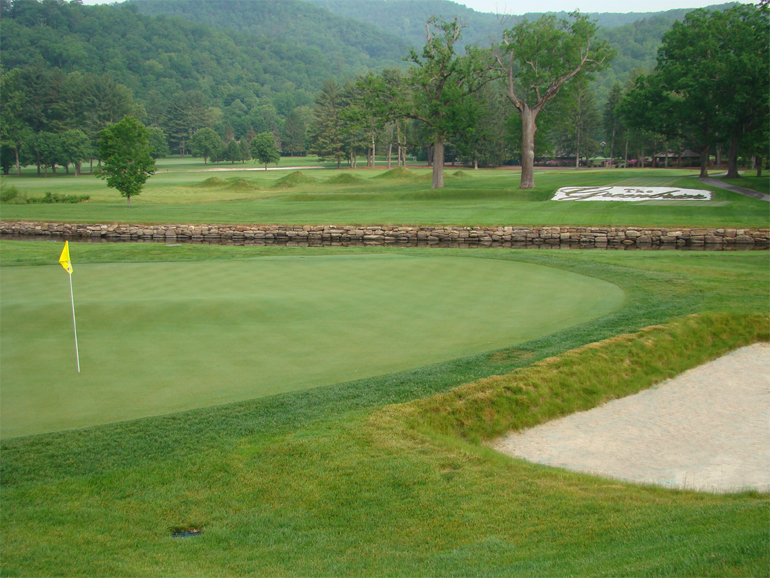
The mound is evident in this striking view from behind the green.
The Old White was built during the Golden Age of golf course architecture and there is a joy found here that eludes most courses built after World War II. Think about how much fun it is to play the Biarritz with the hole location down in the swale or to find the hole just prior to the hump on the eighteenth; these are genuine hole in one locations that might send a lucky guest home with a big smile and a story to be oft repeated. More likely, the golfer simply enjoys the chess match with the architect as to where to best position his ball for his next shot.
Given its remote location in the Appalachian Mountains, few resort guests vacation for less than several days and one thing that they can know with certitude is that they will never tire of playing The Old White. Though the resort possesses two other fine courses, those who enjoy the strategic dilemmas as dished out by the Golden Age architects will relish several rounds on this course, such is the diversity of its shot requirements that shift on a daily basis.
In its early stages golf in this country golf was not an egalitarian affair. Where there was a polo club (e.g. Piping Rock and Saint Louis) there was a Macdonald course. MacDonald is referred to as the ‘Father of golf course architecture’ in the United States because he was the first and most successful designer to express and implement sound architectural principles. Generally his designs occupied the toniest addresses of the day and were off limits to most. The MacDonald/Raynor portfolio is relatively small and only a fraction of those that remain adequately express the original design. Macdonald might never be as loved as Donald Ross whose four hundred courses are more accessible but his best designs remain significant and vibrant and should be sought out. The Greenbrier is a rare opportunity for the public to play a Macdonald course and wise is the player who seizes it.








